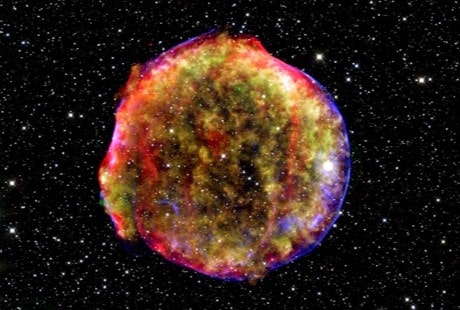

Cosmologists from the University of Portsmouth are playing a crucial role in a new survey that will try and understand the mysterious force known as ‘dark energy’, that is making the Universe expand faster and faster.
The Time-Domain Extragalactic Survey (TiDES) is a new upcoming survey of the night sky that will look for astrophysical objects such as supernovae, the violent explosions that can result from a massive star coming to the end of its life.
In the late 1990s, dark energy was discovered using approximately 60 Type Ia supernovae. Over the last couple of decades, astronomers have been repeating this famous experiment, taking more measurements from hundreds of supernovae events.
In TiDES, scientists will use the 4-meter Multi Object Spectroscopic Telescope (4MOST), based in Chile, to make the measurements from tens of thousands of Type Ia supernovae. The more objects they measure; the more precise results they can get. This will help them to understand; how fast the Universe is expanding, how the expansion evolved over time, and discover more about what the mysterious dark energy actually is and its properties.
It is very exciting to be involved in this new survey that addresses one of today’s most pressing astronomical questions. My role in the survey so far has been to create simulations of the survey, and to determine roughly how many Type Ia supernovae we will be able to get good quality spectral data from.
Researchers from the University’s Institute of Cosmology and Gravitation (ICG) – Elizabeth Swann, PhD student; Professor Bob Nichol, Pro Vice-Chancellor of Research and Innovation (former director of the ICG); and Dr Tom Collett, Dennis Sciama Fellow – are involved in the survey.
Elizabeth said: “It is very exciting to be involved in this new survey that addresses one of today’s most pressing astronomical questions. My role in the survey so far has been to create simulations of the survey, and to determine roughly how many Type Ia supernovae we will be able to get good quality spectral data from.
“I have also been working on predictions of how much we may be able to improve our measurements of the properties of dark energy and the expansion history of the Universe using this new dataset.”
The TiDES survey is a collaboration of scientists from several universities, part of the 4MOST consortium, which is managed by European Southern Observatory (ESO). Portsmouth (and other universities) have contributed to building and developing the survey strategy of the 4MOST telescope, which will be the world leading multi-object spectrograph in the southern hemisphere.
Recently there have been several exciting discoveries of new types of supernovae. These include objects such as Calcium-rich supernova, superluminous supernovae and others. We want to find out more about these strange and exciting object.
Elizabeth and the other researchers involved in TiDES are also hoping to achieve a number of other research outcomes from the project. Elizabeth said:
“Firstly, we want to look closely at the galaxies that these objects explode in. By looking closely at the properties of host galaxies and the properties of Type Ia supernovae, we can better understand the nature of these objects, how they are formed, and how variations in individual objects may affect our results.
“Secondly, looking at objects with a spectroscopic telescope is time consuming and extremely expensive, but necessary to accurately classify astronomical objects for use in cosmology. We want to use the data we will collect on 4MOST to build a reliable dataset of supernovae and their host galaxies. This will allow us to develop artificial intelligence computer programmes, which will be able to classify these objects from just a telescope picture alone, without the need for a spectrograph.
“Finally, we also want to look for ‘supernovae weirdos’. Recently there have been several exciting discoveries of new types of supernovae. These include objects such as Calcium-rich supernova, superluminous supernovae and others. We want to find out more about these strange and exciting objects, what exactly they are, how they might affect our current knowledge on the properties of stars, and how they create and distribute heavy elements throughout the Universe.”
The TiDES project is featured in a special issue of the ESO Messenger.
